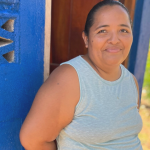Glass Half Full
It is always encouraging to see water flow from water tanks and garden hoses, from spigots and pvc tap stands, from concrete wash basins and handwashing stations, from kitchen sinks and community wells. Water access in rural Central America, no matter the delivery method, is something to be celebrated. But no matter the vessel in which it is received, the proverbial glass is still half empty if accessible water is unsafe. We are on a mission to fill up the cup (and let it overflow!) with safe drinking water. At best, contaminated water can cause chronic diarrhea, stomach pain, fever, and infection. At worst, it can kill.
Water access is but the first step.
Making it safe to drink is where we need your help.
Because of community-minded people like you, we recently collaborated with Constantino and the water board of El Pelon to install a community water system chlorinator in San Juan Intibuca, Honduras. As we stood atop the community’s water tank and watched not just water, but safe drinking water filling its depths to gravity-feed to Constantino’s home and to the families he calls neighbors down below, he completed the first of many water tests to come. And when the water sample turns the perfect shade of pink, confirming the chlorine treatment dosage appropriate to improve the community’s health at long last, he can be confident that it will.
Working with communities to establish simple community water chlorination systems (our signature safe, low-cost, and effective method of treating drinking water) to kill harmful bacteria is but one of the ways we are doing our part to tackle the water crisis – to ensure not only the availability of water for all, but the availability of safe water for all.
Water Quality for Water Equality.
Having lived the devastating effects of bacterial contamination, once safe water is achieved, community members commit to keeping it that way. Every day, our WhatsApp feed fills with water-quality photo proof from the field — pictures of pink viles that would make Barbie-herself proud, of digital displays from pocket-sized readers, of water-quality confirmation from mothers using water to make meals, from water board members making chlorinator adjustments tank-side, from kids who get their feet wet with this important job and who know all too well the consequences of contaminated water.
2.2 billion people still live without safely managed drinking water. To change the statistic, start by changing just one life.






